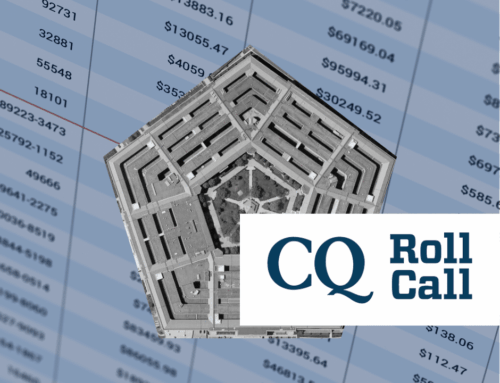This week marks the ten-year anniversary of the September 11 attacks on the World Trade Center and the Pentagon. Our national security institutions have been completely recast in the ensuing decade with the launch of two overseas wars, creation of a new federal agency and increase in domestic security programs.
The “War on Terror,” as President George W. Bush christened this effort, changed our economy as well. The wartime defense budget has more than doubled, and the new Department of Homeland Security grown dramatically. It also changed how we pay for national security: Both wars, as well as portions of the defense and homeland security budgets, were paid for with the use of “supplemental” spending bills off-budget and outside of the regular appropriations process. Though this is no longer the case, we are still living with the consequences of rapidly expanding our national security apparatus on credit.
The concurrence of 9/11’s anniversary with the fight over the debt ceiling and creation of the debt commission brings an opportunity to look back at what we’ve spent, how we’ve spent it and think about what we can do better in the decade to come. TCS has followed War on Terror spending closely from the beginning including our own estimate on the cost of war with Iraq and continuing with analyses of contracting. Over the years we have developed a unique store of resources on its evolution. The following is not intended as a commentary or comprehensive analysis on the post-9/11 national security landscape, but a one-stop shop to help you draw your own conclusions.
Wartime Contracting
A good part of the national security dollars lost to waste, fraud, and abuse over the past decade vanished due to rushed, risky contracts with private companies managed with little oversight. In fact, the U.S. military has become too dependent on contractors in conflicts, concludes the final report of the Commission on Wartime Contracting. The report found that at least one-sixth of the $200 billion spent on the wars in Iraq and Afghanistan—between $30 to $60 billion dollars–was lost to waste, fraud, and abuse. These were contracts that emanated from the Wild West atmosphere in Iraq contracting under the Coalition Provisional Authority , or the slap dash approach that allowed a startup company run by a teenager with no experience to get contracts worth hundreds of millions of dollars that ended up – in part – providing rusty old Chinese ammunition to the military.
But, the conditions that allowed that waste to spread are actually long-standing, systemic problems that TCS has warned of for years. These are succinctly explained in a recent fact sheet, Pentagon Contracting 101 . We identify the same sources of contracting problems as the Commission: Lack of competition; Revolving door between industry and government; Contractors performing government tasks and cost and schedule overruns caused by underbidding by contractors, changing requirements, and lack of oversight.
Costs of War
Even from Washington, it was easy to see costs of overseas wars snowballing. TCS released a report in 2003 titled “Sharing the Burden” estimating the cost of an invasion of Iraq, including build-up, direct costs, replacement costs, occupation, and rebuilding costs. We also highlighted the importance of sharing the financial burden of a post-war Iraq with other nations and the danger of going to war without a plan to pay for it. “While cost alone should never be the deciding factor, any time our nation decides to go to war, the budgetary and economic costs should always be considered and carefully evaluated… The administration’s delay in releasing details about the total costs of the war delays and hampers legitimate debate about the costs of a war in Iraq.”
In 2007, we requested documents breaking down the costs of the War on Terrorism from the Defense Department under the Freedom of Information Act. The documents, called “Supplemental and Cost of War Execution Reports,” are compiled by the Defense Accounting Finance Service, DOD’s financial clearinghouse. DFAS began issuing the reports in 2003 at the request of Congress in order to track the monthly rate of money “obligated” for the War on Terror, meaning money that is committed through payments, contracts, or orders. (Click here for links to Cost of War reports)
The reports reveal how confused and unaccountable war spending has been over the course of the conflicts and how different defense accounting is from Congressional budgeting (DFAS reorganized the reports in 2007 following complaints from Congress that the reports were not transparent enough). They also offer previously unknown details of wartime spending. For example, the Counterintelligence Field Activity, which had a classified budget before it was shut down in 2008, received $100 million in contracts and services between 2005 and 2007, and the Special Operations Command spent nearly $100 million on contractor logistics support between 2005 and 2007. The reports also show that DOD paid contractors at least $13 billion for operations in Afghanistan between 2003 and 2007, or about 15 percent of the $95 billion Congress appropriated between 2003 and 2007 for Operation Enduring Freedom.
Unbounded Homeland Security Spending
On June 6, 2002, President George W. Bush unveiled his plan for a new Cabinet-level agency that would consolidate responsibilities and funding for nine different departments. The Administration claimed that its budget would be covered through savings achieved by eliminating duplication among current agencies, though independent analyses indicated security spending could rise precipitously. The naysayers were right: The first appropriations bill for the Department of Homeland Security (DHS) was $29.4 billion, while the FY2011 bill gave the agency $41.7 billion—an increase of 40 percent.
The gusher of national security spending unleashed by September 11 swamped DHS as well as the Pentagon. The high tech and defense industries immediately began tailoring their products—and lobbying—to the new paradigm, as we pointed out in 2002. One winner was Boeing, who secured billion-dollar contracts for luggage screening equipment as well as the “virtual” border fence boondoggle known as SBI-Net , which was canceled last year after the prototype failed to meet expectations. DHS also spent billions on US-VISIT , another high-tech screening program that has yet to yield results.
Congress helped out by sponsoring Homeland Security Expos where hometown companies plied their wares, an event that continues today. One of the easiest ways to track homeland security pork is through our earmark databases . Earmarks in were almost nonexistent in the early the homeland security spending bills, but 196 earmarks worth $296 million peppered the FY2010 bill. More than half of those went to earmarks for “emergency operations centers” in specific locations, even though the centers are supposed to be awarded competitively by the Federal Emergency Management Agency (FEMA).
Homeland security spending proved a boon to many interests in surprising ways. For example, the airlines received a $5 billion bailout in 2002 under the premise that the industry’s problems were tied to the attacks, despite the fact that its problems predated 9/11. Similarly, insurance executives lobbied Congress for legislation that have made taxpayers provide reinsurance as a backstop for financial risk of future terrorism-related claims, arguing that the entire U.S. economy would suffer after major reinsurance firms, which insure the insurers themselves, refused to renew protection against terrorism.
Conclusion
All the national security dollars wasted over the past decade can actually serve a purpose in the next few months by reminding our leaders in Washington of the potential for savings in the defense budget. There's plenty of money in a more than $700 billion budget for the military to buy what it really needs, as long as it sets priorities and spends its money efficiently. That means adequate oversight, something lost in the contacting explosion. It also means that those who want to keep the gusher going must face the fact that spending smarter makes us safer.










